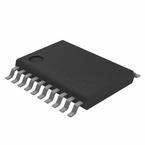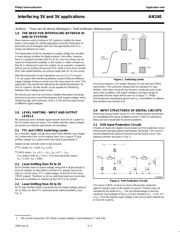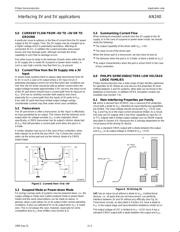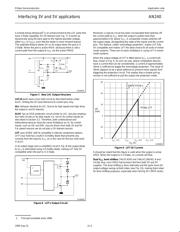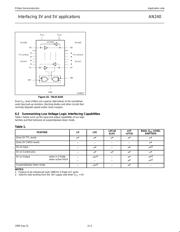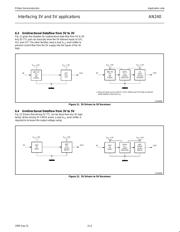herunterladen

Philips Semiconductors Application note
AN240Interfacing 3V and 5V applications
Authors: Tinus van de Wouw (Nijmegen) / Todd Andersen (Albuquerque)
11-1
1995 Sep 15
1.0 THE NEED FOR INTERFACING BETWEEN 3V
AND 5V SYSTEMS
Many reasons exist to introduce 3V
1
systems, notably the lower
power consumption for mobile applications and the introduction of
parts that use technologies with such fine geometries that 5V is
simply not allowed any more.
The introduction of the 3V standard as supply voltage has resulted
in many design activities for digital systems. Very often, however,
there is a gradual transition from 5V to 3V, since not always are all
required components available, or the system is rather complex so
that 3V is introduced in part of a system. As an example, customers
wish to use an existing and proven CPU, while a new, more complex
ASIC with added features can only be made with 3V. Or vice versa!
With the introduction of new standards such as 2.2-2.7V or even
1.7V we expect that interfacing between systems that use different
supply voltages will be an actual issue for many years to come. This
application note specifically addresses the interfacing between 3V
and 5V systems, but the results can be applied for interfacing
between other voltage levels as well.
We will discuss how one can ensure reliable information exchange
and how to prevent current flow between both supply voltages when
interfacing logic with memories, ASICs, PLDs and microprocessors
at different supply voltages.
2.0 LEVEL SHIFTING - INPUT AND OUTPUT
LEVELS
We obviously want a reliable signal transfer from the 5V system to
the 3V system and vice versa. This implies that the output voltages
should be such that the input levels are exceeded.
2.1 TTL and CMOS Switching Levels
As a reminder, digital circuits have input levels defined: one voltage
(V
IL
) below which the circuit certainly sees it as a logical “0” and
another voltage (V
IH
) above which the input is guaranteed “1”.
Digital circuits normally come in two versions:
•TTL levels: V
IL
= 0.8V, V
IH
= 2.0V
•CMOS levels: V
IL
= 0.3 V
CC
, V
IH
= 0.7 V
CC
.
For systems with V
CC
= 5.0 0.5V this practically means:
V
IL
= 1.35V, V
IH
= 3.85V.
2.2 Level Shifting from 5V to 3V
All 5V families have an output voltage swing that is large enough to
drive 3V reliably. As described in Section 4.0, outputs may be as
high as 3.5V for many “TTL” output stages, to the full 5V for many
CMOS outputs. Therefore, as far as switching levels are concerned,
there are no problems in interfacing from 5V to a 3V system.
2.3 Level Shifting from 3V to 5V
All 3V logic families deliver practically the full output voltage swing of
3V, so they can drive TTL switching levels without problems (see
Fig. 1).
2V
0.8V
SV00084
70%
30%
V
CC
GND
3.3V
OUTPUT
CMOS
LEVELS
TTL
LEVELS
Figure 1. Switching Levels
One issue remains: a 3V system driving a 5V one that has CMOS
input levels. This cannot be reliably done by standard 3V logic
families, even when using pull-up resistors, simply because under
worst case conditions, the output voltage is not high enough to
guarantee that the signal will be seen as a logical “1”. Philips
Semiconductors developed special dual V
CC
levelshifters to address
that situation (see Section 6.0).
3.0 INPUT STRUCTURES OF DIGITAL CIRCUITS
Before discussing further issues on 3-5V interfacing we should start
by investigating the inputs of digital circuits in order to understand
what care one should take to prevent problems.
3.1 ESD Input Protection Circuits
Virtually all inputs of a digital circuit contain an ESD protection circuit
that prevents damage against electrostatic discharge. This circuit is
present between the physical input pin and the active circuit. Two
popular schemes are given in Fig. 2.
V
CC
R
S
INPUT
R
S
INPUT
SV00081
Figure 2. ESD Protection Circuits
The classic CMOS scheme as shown left provides protection
against negative zaps by the diodes to ground. Positive zaps are
clamped by the diode to V
CC
. The real disadvantage is that the
maximum input voltage of such a circuit is limited to V
CC
+ 0.5V. For
a V
CC
of 3V the allowed input voltage is too low for direct interfacing
to most 5V systems.
1. We use the expression “3V” when a supply voltage is used between 2.7 and 3.6V.

